Due to the large amount of threads and the quality of the content, texts and images, I do not always react to every thread, but I appreciate them very much. I have spend reading and watching many topics, texts and images (old photographs, new photographs and images of art works over here).
So they all are very much appreciated. We as 100% ethnic Poles (you, Pawian, Tufta/Adam, Bunjo, Jerzy, Zoba, Jaga) and 50% ethnic Poles (me and others with one Polish parent) are on the crossroads of cultures, because we were born in families with different cultures, or because you lived in cities with universities, Research & Development centers, Contemporary Painters, Sculpturists, Graphic artists, internationally renowned Polish Theatre with new Theatre technics, acting methods and theatre skills, musicians and people with intellectual professions (professors, researchers and other professionals -like scientists- of the Uniwersytet Jagielloński), curators of art insitutions and art exhibtions (for instance in Bunkier Sztuki), art historians, journalists, authors and poets, political thinkers (theorists), sociologists and thus International visitors and residents who feel attracted to the intellectual, cultural, scientific, historical and academic climate of Kraków (or Warsaw, Poznań or Wrocław).
I heard from Dutch people, Germans, Americans and Israeli's that Poland is a country with an old authentic culture, civilization and sophistication, due to the way the men treat the women, the young the old and their attitude to strangers. A Dutch politician with a Polish wife told me the Poles have a very refined and sophisticated society, due to the fact that Poland has a lot of cities and towns with universities, schools of economics and Universityies of Technology, like the Politechnika Krakowska im. Tadeusza Kościuszki in Warszawska 24, 31-155 Kraków, Poland. Despite the fact that he devorced from his Polish wife he had very fond and dear memories of Polish family, Polish friends, Polish colleages of his former wife (who still lives in the Netherlands and has a relationship with another Dutch man), and the level of education and civilization of Polish people in general. This Arnhem man called them very sophisticated, humble, gentle, academic people often with good old values as decency, politeness, good manners, inner civilization, intelligence, culture, and pleasent company. Like other decent Dutch people he was irritated and offended by Polonfobic attituded and statements of felow Dutch and rightwing Populist (Dutch Nationalist) politicians. He said; "
They have a certain sophistication -being cultured-, old fashionate gentlemen and lady behavior-, ethics, values and customs, we might have lost in the Netherlands, with our Americanization, artificial materialist pragmatism, blunt culture and lack of sense of historical awareness, propper use of our own language and respect for our own culture, without neglecting or ignoring other cultures that have influenced us."
Foreign visitors like the Polish style of living, the politeness of many Poles and their civilization), but also a strong connection to the West (Paris, London, Chicago, Milwaukee, New York, Berlin and the Hague -with it's large Polish community, the only Dutch city with a large Polish community-). Young Poles speak English, German, French and some of them Dutch, Russian, Hebrew or Spanish. Maybe like in the Netherlands some Polish students might study Chinese?
The Dutch and German students I was with in Kraków in April 2004 and myself witnessed the differences in behaviour in Kraków, Poland, and in our own Dutch and German cirties and towns. Maybe we had a Romantic view as visiting Art Academy students, art teachers, artists and professionals in other fields, but we liked the climate in Krakow, the Modernisation we saw (we saw new highways, new Business districts, and the Old city center, the Wawel Castle with the Wawel Cathedral and the old Jewish neighbourhood Kazimierz, where we went to Polish Cabaret and Musical performances, student pubs and an alternative (Underground) Polish NewWave club (with Polish youth, students and Gothic, Punk and Hard rock looking Poles). Thank god we had a blond Polish-Dutch student with two Polish parents, who spoke Polish fluently, and who had contacts in Kraków. So he showed us the non-Touristic parts of the city, also outside the city center. The various faculties of the Jagiellonian University, nice lunchrooms, traditional Polish restaurants where the Poles go to and not the tourist restaurants. Due to his Polish ethnicity and Polish language skills he was our Polish cultural and social guide during the week. Nex to that I was wondering around the city with a German (female) student friend, Ivonne, a Dutch Turkish-Kurd student friend, Pakize (Fashion designer and art lover), and a Dutch fellow art student Han. With Han I was some sort of duo, and Ivonne and Pakize were also some sort of duo. We fellows were sometimes impatient when Pakize and Ivonne filmed and photographed nearly everything, from flowers and romantic Polish couples in Planty or at the river banks of the Wisla (we all considered the Poles to be very romantic, because we saw beautiful young Polish couples everywhere, and older couples, characteristic old men or women sitting on park benches or walking in the old city, at the hill of Wawel or at the old town market square.). Impatient Han and me liked to walk and run around, and also (secretly) enjoy the looks of the beautiful Polish ladies with their Western slavic charm. We were all singles and enjoying life, and I kind of liked a female German student of the Arnhem Art Academy - Fine Art department very much, Actually after the bus journey from the Netherlands to Krakow and our settlement, breakfests in Hotel Start in Kapelanka 60 near the huge Tesco supermarket at Kapelanka 54. My first contact after I had find the courage to make contact with her was in the Leonardo da Vinci's Lady with an Ermine painting in the Czartoryski Museum. It was a beautiful, tall, blond, blue eyed girl from Lübeck, and she had spend one year in the Czech Republic as an art exchange student before she went to the Arnhem Art Academy - Fine Art department (the department I studied Painting, drawing, sculpture, photography, art history and art video -filming and editing_ from 1992 until 1995. One year Amsterdam, I year the Hague Art Academy, and three years Arnhem Art Academy). I even went with her and other Dutch and German students to the Auschwitz concentration camp, which was a very tough and confronting experience for me. And for her, she was very emotional, like if she carried German guilt. Our emotions were different and we had to part for a moment. I was there and thought about my Polish grandmother who was in Mauthausen concentrationcamp (deported to Austria in a cattle wagon after the faillure of the Warsaw Uprising in 1944) as a Polish Untermensch (sorry for that degratory term), and a Polish aunt from Warsaw who was caught in one of these notorious Łapanka's (roundup), by the German/Austrian Sicherheitsdienst (SD), Gestapo, Schutzstaffel (SS) men or Wehrmacht units (sometimes the Wehrmacht also acted as German police forces, you had bad elements in the Wehrmacht too). She was caught somewhere in 1940 and spend the war in Auschwitz until she was rescued by the Red Army which liberated the camp. Her father was murdered in the SovjetUnion like many Poles, but she became a member of the Polish United Workers' Party (PUWP; Polish: Polska Zjednoczona Partia Robotnicza, PZPR) and a neighbour of the sober (humble) living Wojciech Witold Jaruzelski in Warsaw. She was a pariah in the very Roman-Catholic, Patriotic and anti-communist family. But despite the dislike for the Communist regime and communists, my Polish grandparents stayed in contact with her. Disliking her Communist husband though, but you can't choose your family they sometimes say. Contact remained between my Polish communist aunt and my Non-Communist grandparents in Poznan. They never talked about politics, foreign affairs or other subjects that might cause friction. I remember that we visited her, but that my mom didn't felt comfortable. You can imagine that. My mother particulary disliked the husband of my aunt. There was something strange about the man. He had a strange look in his eyes, and it was like he was hiding something. Family members agreed about that. The aunt was a good and decent person, despite her party membership and thus belonging to the wrong party and thus direction. Other familymembers next to my grandparents never had contact with my communist aunt again, after 1945. She was the black sheep of the family. In Auschwitz I also thought about my dear Dziadek (grandfather) in the Mokotow neighborhood in Warsaw, Josef Kotowicz, who was under constant threat in Nazi occupied Poland, because he happened to belong to the Polish intelligentsia and elite. He was a teacher at a Girls lyceum in Warsaw and an inspector of a Warsaw schooldisctict for the Polish ministry of education. I believe, but can't prove it right now that he was part of the Underground education system in Poland. I remember that my mother or babcia (Grandmother) told me that he had always a small suitcase with clothes and necassery things for surivival standing ready next to the table from 1939 until late 1944, in case the Gestapo would come for him, every day. My dziadkek could have been a victim of the Nazi
Intelligenzaktion (
pl.wikipedia.org/wiki/Intelligenzaktion ). He had connections with informers of
the Polish Underground, but you never knew when a house search or
Łapanka took take place. They lived in the wrong area in Warsaw, meaning in an area with a Gestapo prison (
Mokotow prison (
en.wikipedia.org/wiki/Mokot%C3%B3w_Prison ), behind their apartment, let's say in their backyard), an SS officers school and Wehrmacht barracks in the neighbourhood. My grandmother once was forced as human shield in front of Waffen-SS men walking in front of them through a Mokotow street. Bullets of marksmen and markswomen of the
Armia Krajowa flew around her ears, neck, arms and legs. The German Wehrmacht, and the German, Austrian, Ukrainian and Russian Waffen SS in Warsaw especially feared Polish women because they were excellent sharpshooters.
 Warsaw Uprising A female Polish partisan, September 1944.
Warsaw Uprising A female Polish partisan, September 1944.Wehrmacht and later SS forces extensively used Polish civilians as human shields during Warsaw Uprising when attacking the insurgents' positions. I was relieved when I came back to Kraków, because the experience in Auschwitz had been intense, personal and emotional due to the mixed emotions and different points of view and historical national connections of the people of the group we visited Auschwitz with. I had some difficulties witn the mass tourism there, and American tourists with baseball hats and their artificial, lack of knowledge of history, and visiting the concentrationcamp like it was a theme park. Enough with my judgements and stereotyping now. Ofcourse there are decent, intelligent and empathic American visitors there too. I just had some dificulties with the mass tourism there.
The Polish guide was very good, but also very overwhelming in his detailed fact telling story. About the Industrial, methodical way of mass murder in that dark place. Like he told the story of a Auschwitz camp commander, who was furious that the production aim wasn't met. Meaning thousands of murders a day. I don't know about which camp commander the Polish guide was talking; SS-Obersturmbannführer Rudolf Höss (1940 - 1943/1944), SS-Obersturmbannführer Arthur Liebehenschel (1943–1944) or
SS-Sturmbannführer Richard Baer (1944–1945). It doesn't matter, it was crual, inhumane and insane enough. The Polish guide told me he learned a lot every day in his work, from former Jewish, Polish, Hungarian, Dutch, German, Gypsy, French and Austrian concentration camp prisoners. He told me it was his job, but that he didn't watch war movies or war games at home. His life was normal outside the camp, and he was aware of his duty to inform visitors (the world) about what had happened there. He was a very good, well informed, rational-analytical guide, who knew a lot. One of the most brutal moments or memories was when we went in to the hell inside the hell of Auschwitz and that was the Gestapo prison building, Block 11, a brick building in the so-called Stammlager (Auschwitz I main camp). The level of cruelty against local Polish resistance members, farmers, towns/village people, and internal Jewish and Polish resistance in the camp was incredible. I don't want to mention it here. Forum members and visitors can read about it in Wikipedia or watch war movies or documentaries about that. I was aware at that moment in Auschwitz what suffering had come over the Poles and Jews during that five years (1939-1945), which took 6 million Polish lives (3 million Polish Roman-Catholics and 3 Million Polish jews, which were half of the murdered European jews). 1 million people were murdered in that place, and I was there and I felt the heavy ground and saw the huge structure of Auschwitz-Birkenau (Auschwitz II), the barracks, the gas chambers, the blown up crematories, the gate with '
Arbeit Macht Frei' in Auschwitz I ( former Polish army barracks).
The week in Kraków was amazing and for me it was the end of a Central-European Art Academy bustrip, art week journey, of Prague (1994), Budapest (1995) and Kraków (2004). Three cities with very distinct, authentic, national, Czech, Hungarian and Polish atmospheres, culturesm histories, civilizations and peoples, but also three cities with a layer of Austrian Habsburg heritage, which merges with the older Polish, Czech and Hungarian layers of history.
.png)
Founded in
1364 by
Casimir III the Great,
the Jagiellonian University is the oldest university in
Poland, the second oldest university in Central Europe, and one of the oldest surviving universities in the world. Notable alumni include, among others, mathematician and astronomer Nicolaus Copernicus, Polish king John III Sobieski, pope John Paul II, and Nobel laureates Ivo Andrić and Wisława Szymborska. And ofcourse the old St. Mary's Basilica, Sukiennice, the Wawel Castle and Cathedral and theJuliusz Słowacki Theatre are typical Polish. So like most historical cities Kraków is interesting and beautiful due to it's historical layers, it's general history (old History, New History, Newest History), art history (the Romanesque, Gothic, Renaissance, Baroque/Rococo [Late Baroque], 18th and 19th century Classicist buildings and churches, and 20th century Modernism, Communist building styles, and Post-Modern, Post-communist new Architecture.
By the 1930s, Kraków had 120 officially registered synagogues and prayer houses that spanned across the old city. Much of Jewish intellectual life had moved to new centres like Podgórze. This in turn, led to the redevelopment and renovation of much of Kazimierz and the development of new districts in Kraków. Most historic buildings in central Kazimierz today are preserved in their original form.
Communist architectureAfter
the Second World War, new government turned toward
Soviet influence and the
Stalinist monumentalism. The doctrine of
Socialist realism in
Poland, as in other countries of
the People's Republics, was enforced from
1949 to
1956. It involved all domains of art, but its most spectacular achievements were made in the field of urban design. The guidelines for this new trend were spelled-out in a
1949 resolution of
the National Council of Party Architects.
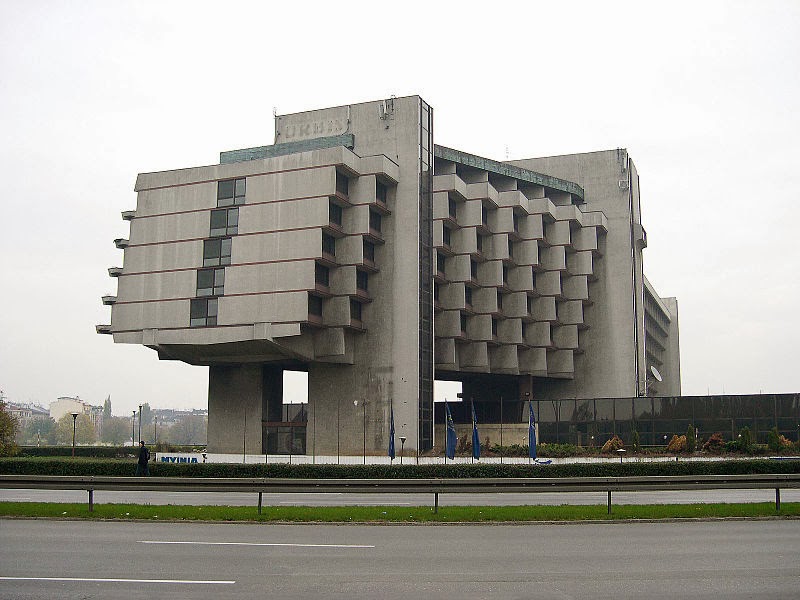 Brutalist Architecture and Social Realism in Kraków
Brutalist Architecture and Social Realism in KrakówArchitecture was to become a weapon in establishing
the new social order by
the communists.
The ideological impact of urban design was valued more than aesthetics. It aimed at
expressing persistence and power. This form of architecture was implemented in the new industrial district of
Nowa Huta with apartment blocks constructed according to
a Stalinist blueprint, with repetitious courtyards and wide, tree-lined avenues.
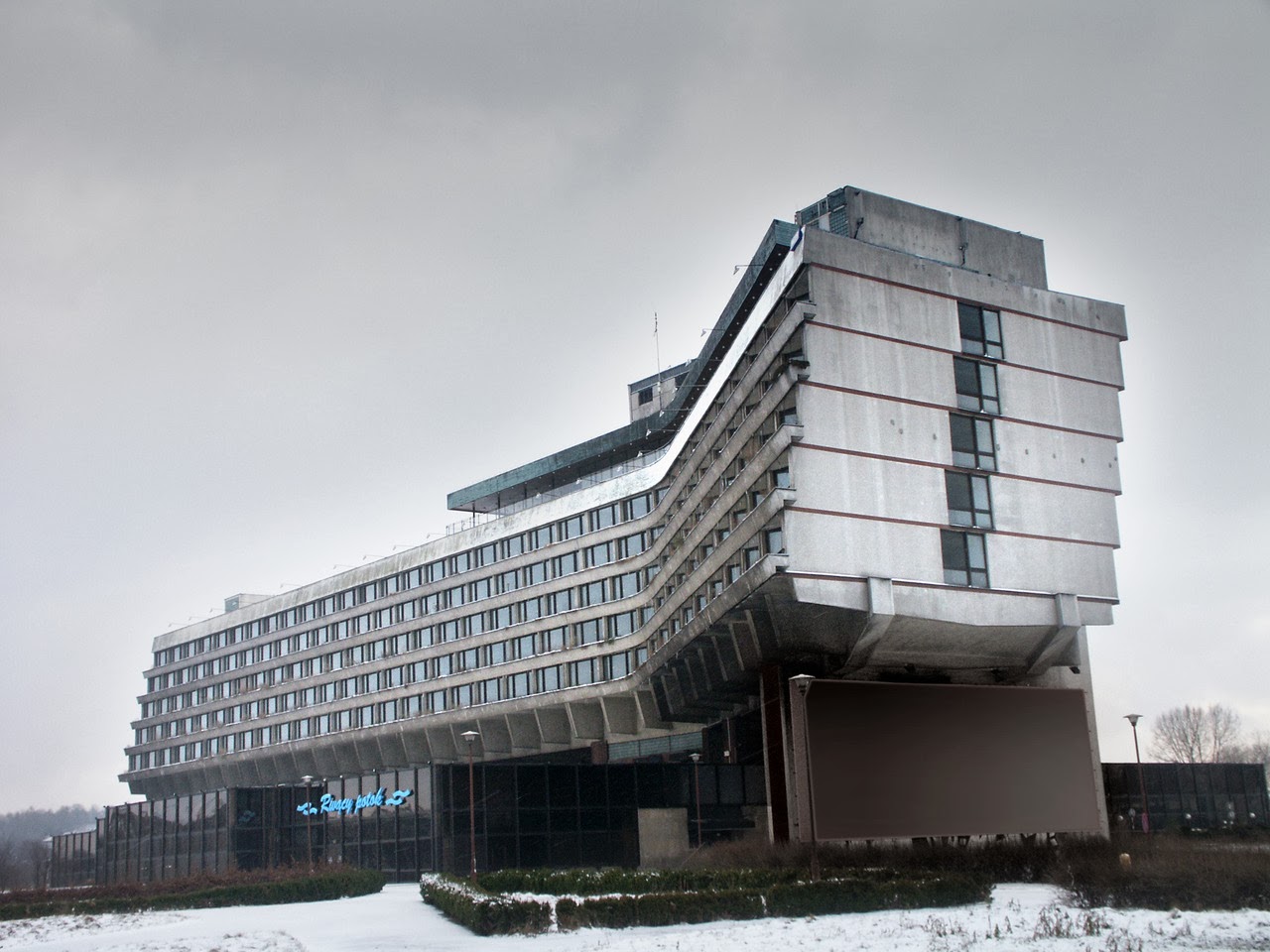 You become depressive only looking at the building. I have to say that in the West we have our own version of this depressive Stalinist monumentalism.
You become depressive only looking at the building. I have to say that in the West we have our own version of this depressive Stalinist monumentalism. This is an example of West-European socialist depression. The social democratic projects version of the Communist architecture in the Peoples Republics of Central- and Eastern-European countries.Kraków's 21 century architecture
This is an example of West-European socialist depression. The social democratic projects version of the Communist architecture in the Peoples Republics of Central- and Eastern-European countries.Kraków's 21 century architecture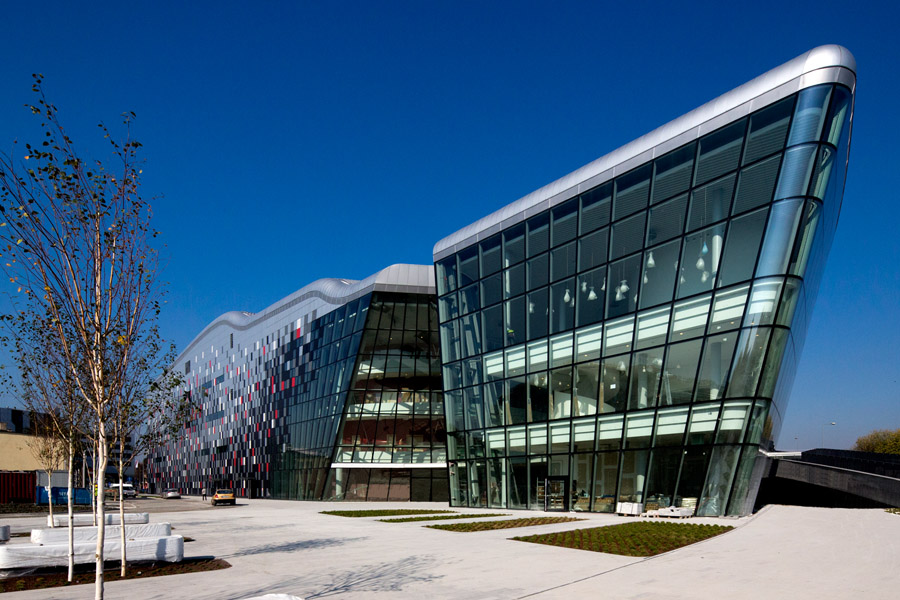
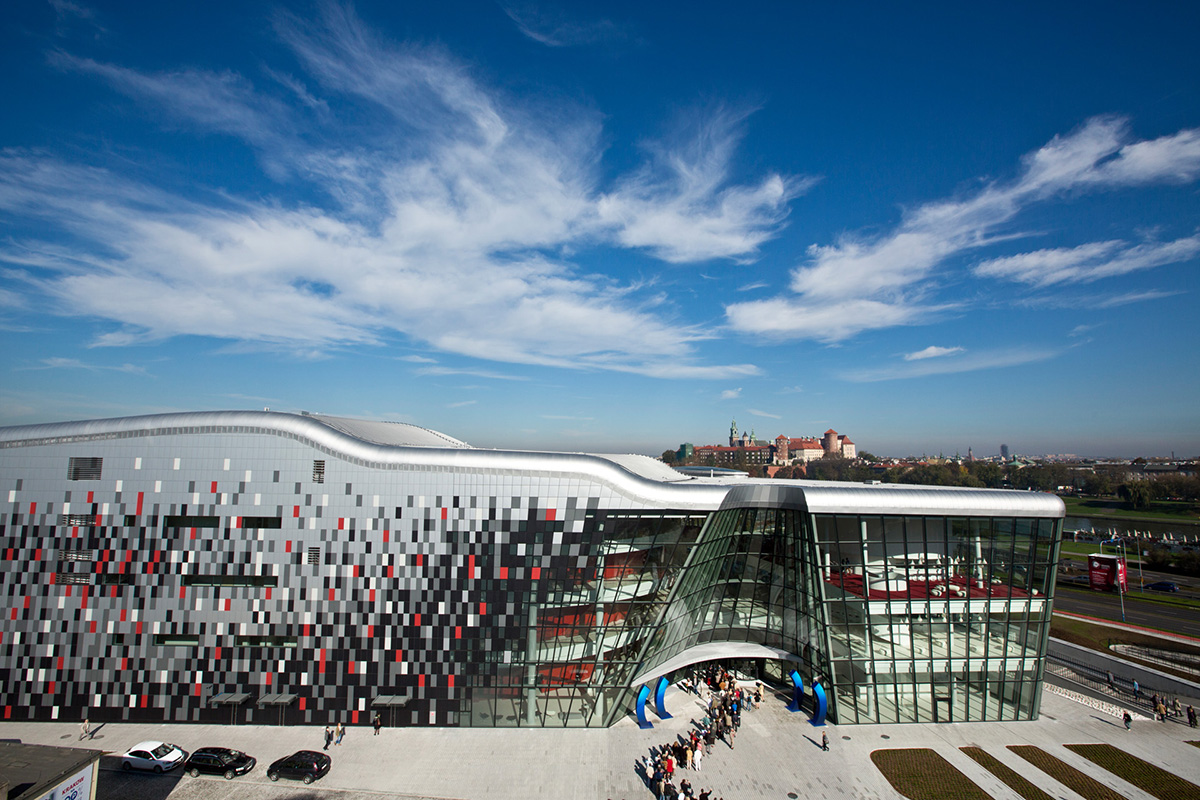

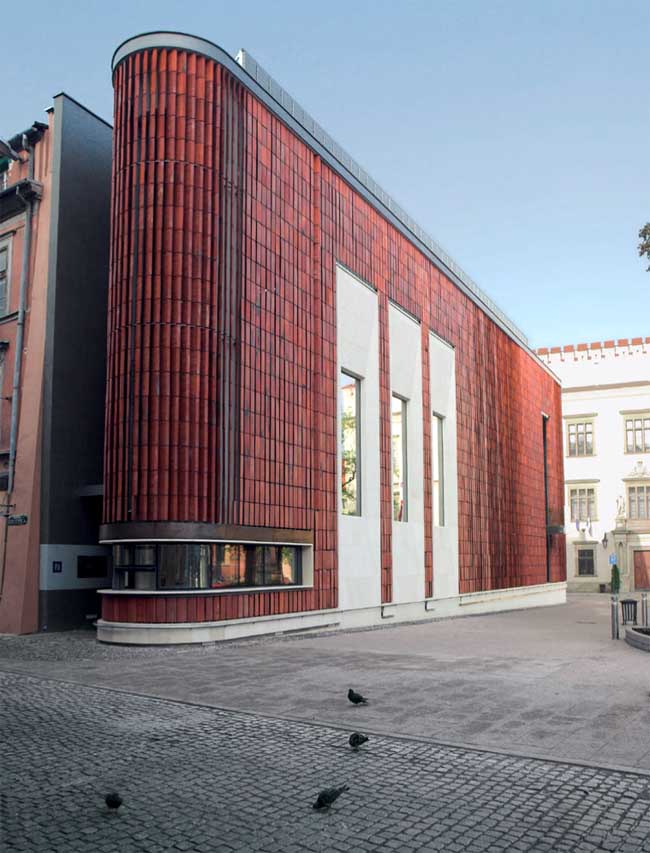
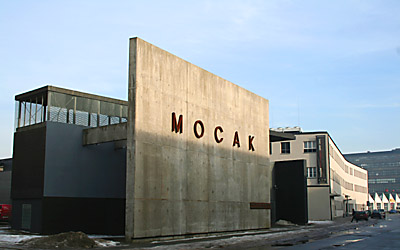
 Museum Tadeusz Kantor
Museum Tadeusz Kantor Museum Tadeusz Kantor
Museum Tadeusz Kantor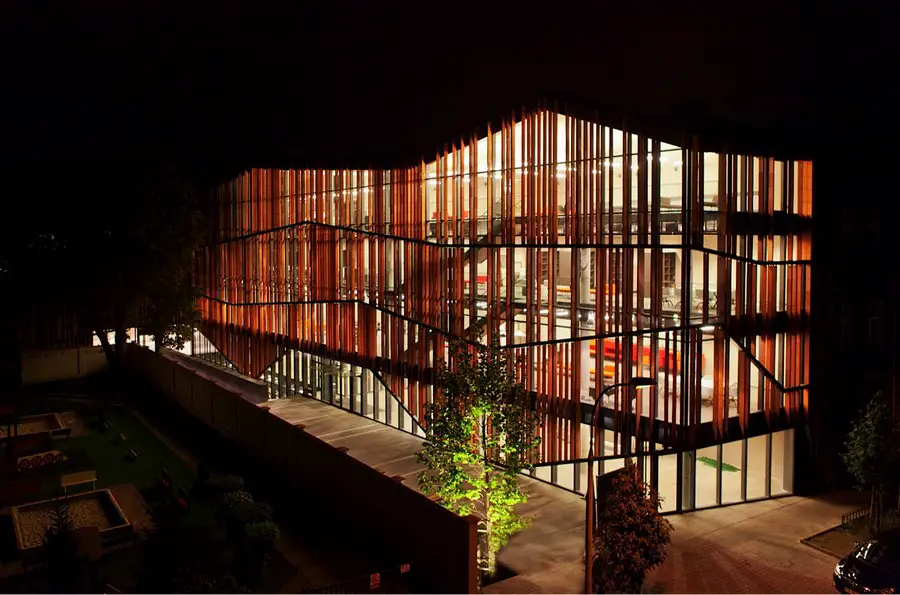 Małopolska Garden of Arts Krakow Building
Małopolska Garden of Arts Krakow Building The Museum of Contemporary Art in Kraków
The Museum of Contemporary Art in Kraków The Museum of Contemporary Art in Kraków
The Museum of Contemporary Art in Kraków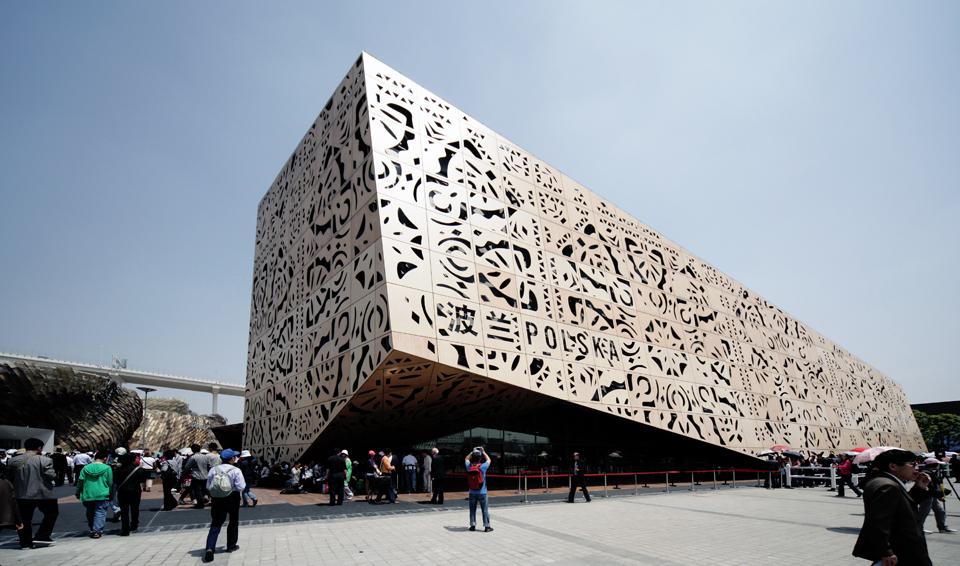 Małopolska Garden of Arts
Małopolska Garden of Arts











.png)













